October was a month of planning and starting new projects. Demolition, construction, plus repairs after Hurricane Ian took up much of our time and energy. Here’s what happened in our gardens in October.
Hi there, and welcome to my monthly series about how I grow food year-round in a sub-tropical climate. Each month I’ll share with you my observations and notes from my garden journal. I’ll also include gardening tips, monthly harvest tallies, and my favorite resources related to the season.
Alisa
Click the links below for shortcuts to each section.
- Journal Entries Weeks 1 & 2
- Journal Entries Weeks 3 & 4
- What’s Blossoming Now
- Harvest Summary
- Resources
- What’s Next
- What Do You Think?
Journal Entries Weeks 1 & 2 October 2022
Cleanup after Hurricane Ian was our highest priority the first week of October. The storm had knocked down two tall dead pine trees, many tree branches, and spread plant debris around the property. It also flipped over a metal building that had just been built on the property two weeks earlier. This was going to be our machine shed to store the tractor, implements and other equipment. Now, after Ian, it was sitting upside down in the field next to Mike’s workshop. This became a huge project for us in the coming weeks.

After completing most of the clean-up (except for the upside-down building), we moved on to our other projects planned for October.
We put the wood chipper to good use and chipped all the debris from the storm. Mike cut the pine tree trunks into large sections and set them aside for later.
Three more dead pine trees were in danger of falling. We pulled them down with a long chain attached to a truck. They broke off easily since they were rotted through. We cut them up, chipped the branches, and piled up the long logs for a future project.
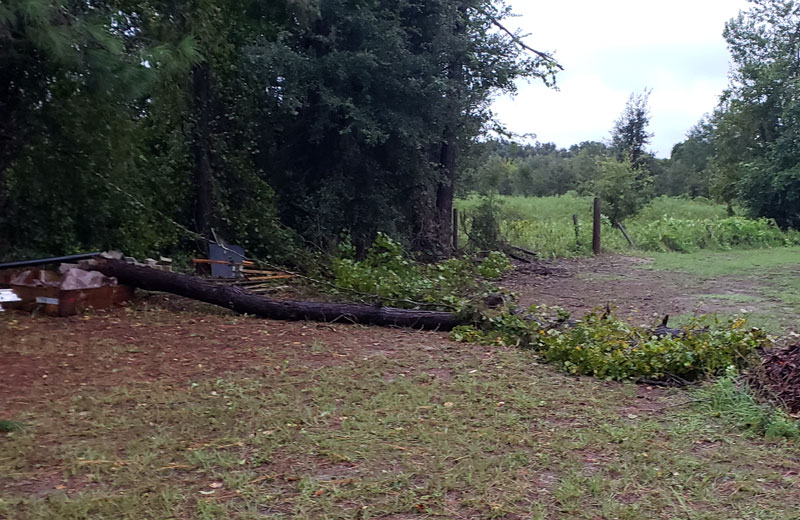
The shed we had been building around the well was also completed. Mike even put up a water spigot behind the shed for easier access.
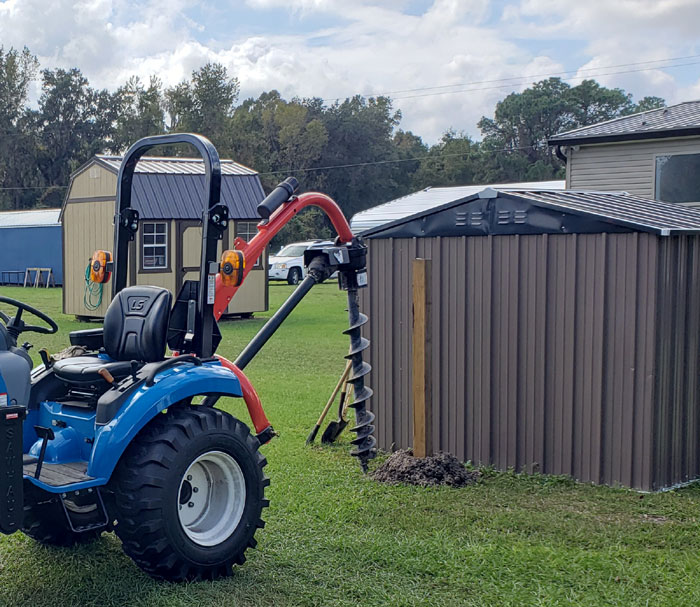
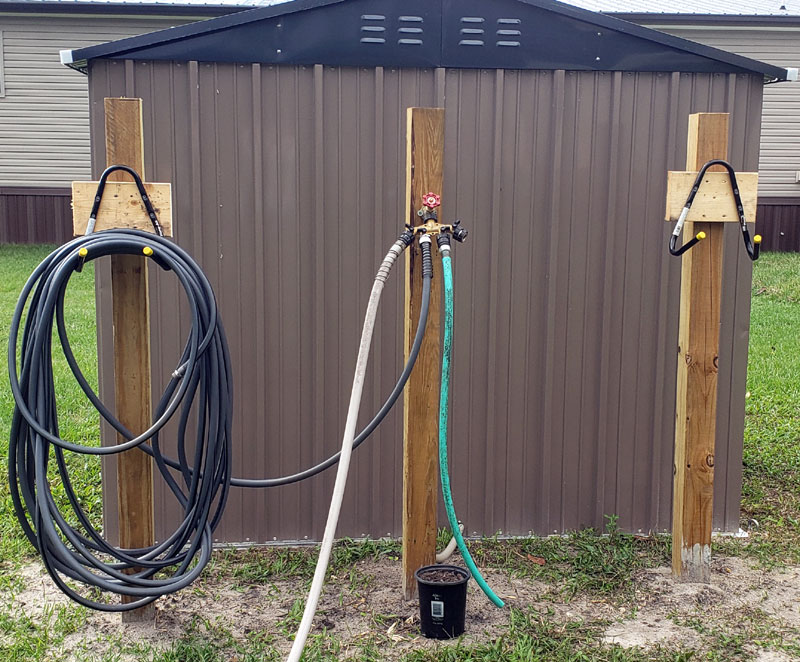
We created another raised garden bed from an old shipping crate I had salvaged from my place of employment. Mike reinforced it with screws and added a brace across the middle. We stapled half-inch hardware cloth onto the bottom to keep out any rodents. Once we flipped it over, we put down a layer of flattened cardboard boxes, about two inches of oak mulch, then completed the fill with topsoil from the property.
The following weekend, I planted sweet yellow onions and a few sweet potatoes in that raised bed. I topped it all off with a layer of green mulch from the pasture.
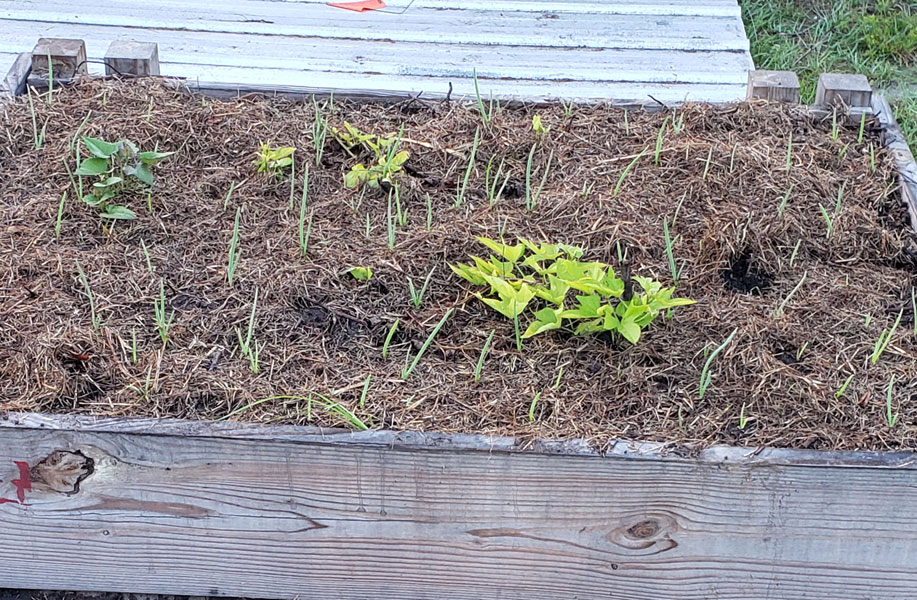
Another big project for October was tearing down an old 10’ x 12’ metal shed that was on the property when we bought it. We emptied it out, filled a dumpster with a lot of what was in there, and gave a bunch of scrap metal to a local scrap metal seller.
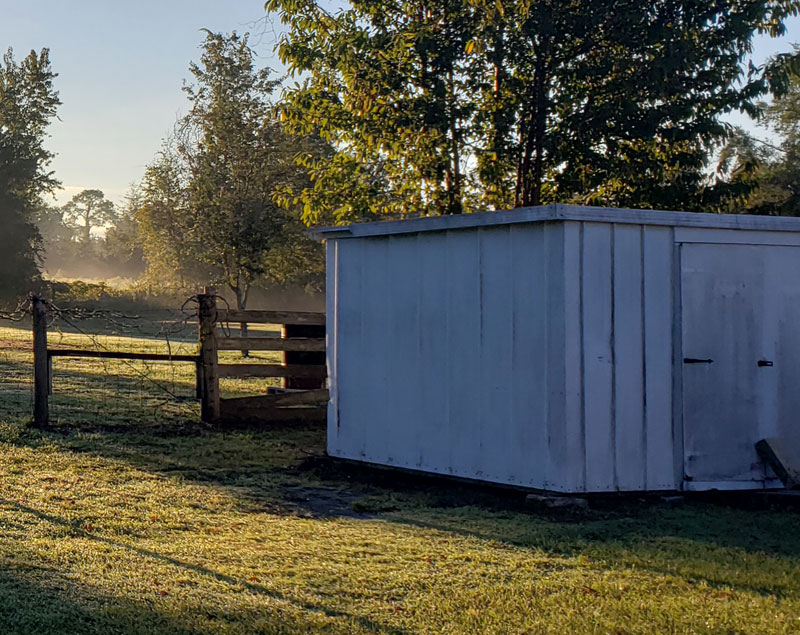
Mike used the tractor to clear and level the ground after the demolition was done. Then I raked in a mixture of wildflower seeds and kept it watered well. This area would now become our pollinator garden. Other projects took higher priority, and we put off completing the shaping of the pollinator garden until another time.
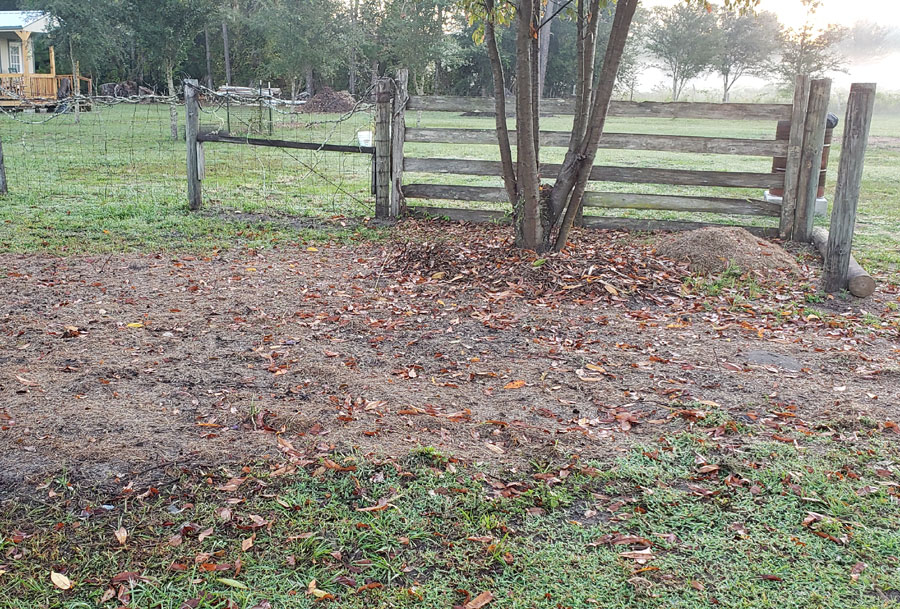
Journal Entries Weeks 3 & 4 October 2022
With all the infrastructure work going on, I didn’t have much time to put in a fall garden. Instead, I continued to nurture what was already planted.
The longevity spinach and Okinawa spinach started growing better once the heat of summer went away. I started pinching the branches back to encourage bushy growth. These perennial plants make excellent ground covers and are delicious cooked or fresh in salads or on burgers.
Several of the Seminole pumpkins started turning an orange-sand color. It would only be a few more weeks until I could harvest them. Their leaves showed signs of stress and lack of nitrogen.
Our soil is very low in nitrogen. For now, I am using a general garden fertilizer to help my plants grow. Eventually, I plant to use green manure and cover crops to provide nutrition for my gardens. I have links in the Resources section with more information about those two practices.
Other projects I completed include:
- Plant 5 loquat trees in the food forest
- Plant more pigeon peas
- Reinforce the fence between the back yard and garden
- Move pine logs along border of food forest and flower beds
- Tie up growing dragon fruit
- Weed, mow, mulch, and trim.
The last large project for the gardens this month was to build 3 more raised beds. Mike and I spent one Saturday morning building the 4’ x 8’ beds, attaching the hardware cloth, and filling them just like the one we had built earlier this month.
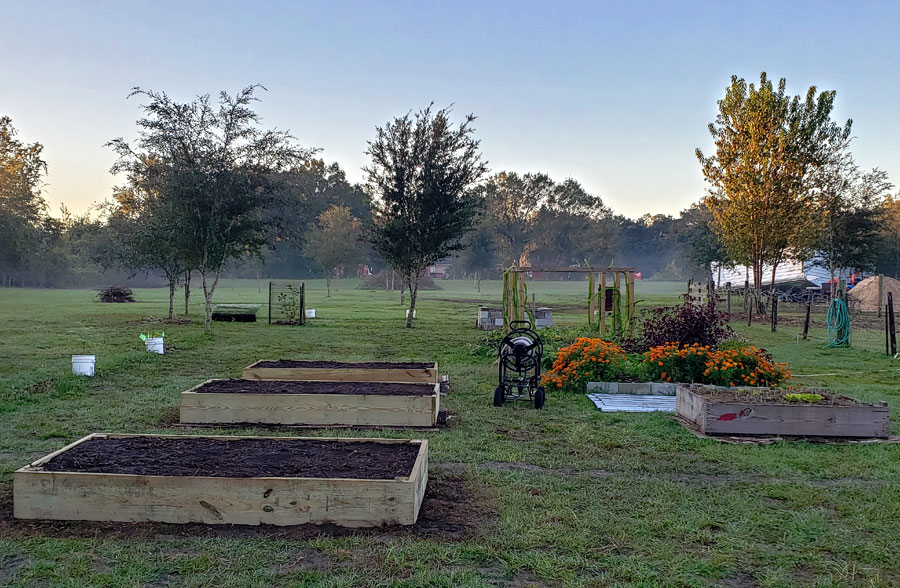
After all that work, I treated myself to attending a festival. The last weekend of October, I went to A Natural Farm’s Learn and Grow Festival. A Natural Farm is a local nursery in Howey in the Hills, Florida. They are my feature resource for this month.
I attended several workshops, visited the vendors, and bought a few ground -cover plants from their nursery. I had a wonderful time, learned a lot, and plan to go back and buy my apple and peach trees from them later this season.
Overall, October was very busy and productive. It was easier to work in the slightly cooler weather of autumn. The hurricane set us back a bit, but we pushed through with our projects to set systems in place for the future of our food forest and raised bed gardens.
What’s Blossoming Now
This month, I’m adding a new section to my monthly garden journal all about what plants are blossoming. This will give you (and me) a calendar of sorts to track what is growing all year round.
Here’s a list of blossoms you can find in October in Central Florida on my homestead:
Trees and Shrubs:
- Loquat
Edible Fruits and Vegetables
- Seminole Pumpkin
- Basil
Flowers and Wildflowers
- Marigold
- Orchid
- Perennial Peanut
- Biden Alba (Spanish needles)
- Dog vomit slime mold
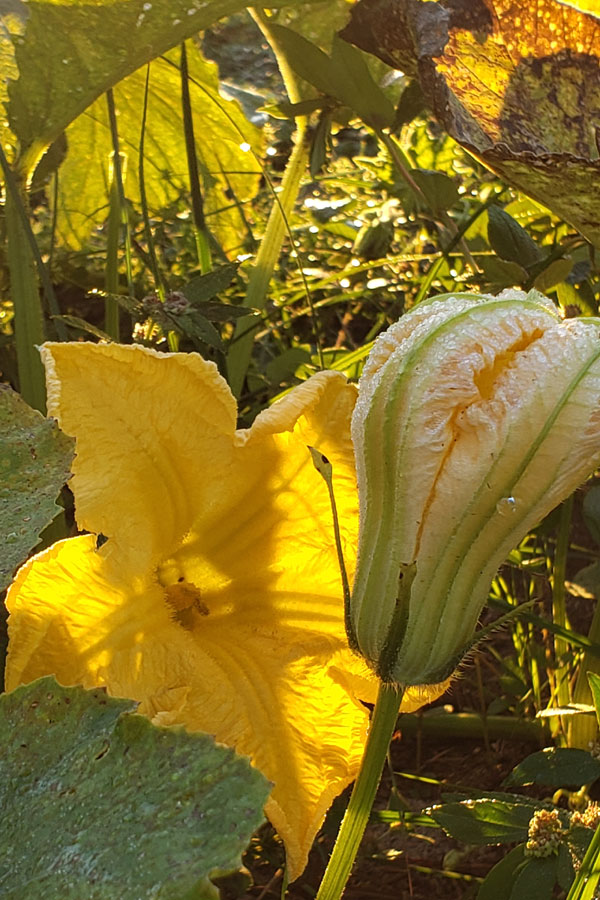
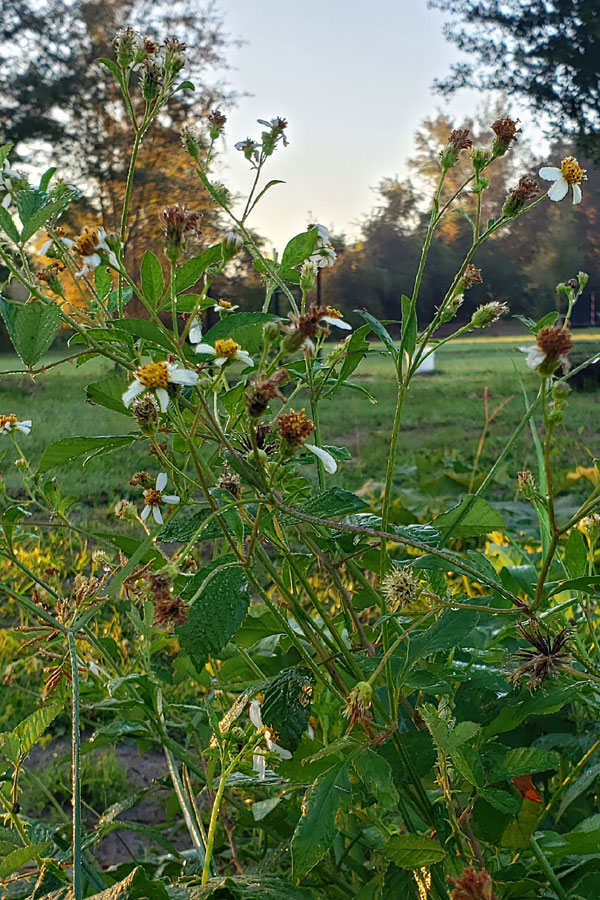
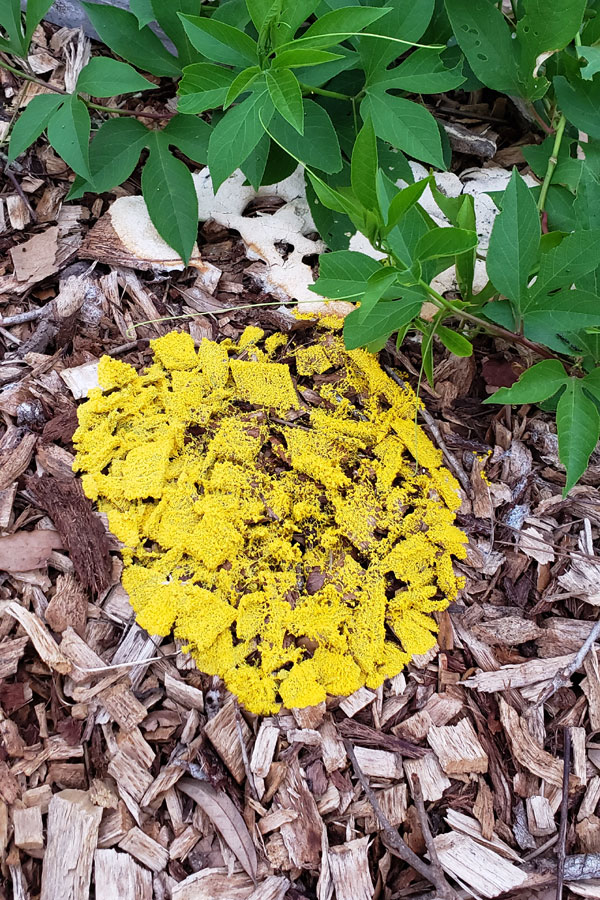
Harvest Summary
We didn’t have much to harvest this month. Building structures and setting up systems for future harvests was our primary goal. However, I still snacked on the spinaches and basil. I also dried cranberry hibiscus leaves for tea.
- Longevity spinach
- Okinawa spinach
- African blue basil
- Cranberry hibiscus leaves
Resources
Here are some resources for things I mentioned above in the post. Make sure to check out A Natural Farm. It’s a great place to get naturally grown plants for your forest garden.
- A Natural Farm (local nursery)
- Green Manure – what is it?
- Biden Alba – an awesome wildflower for the pollinators! (YouTube link)
- Dog Vomit Slime Mold – not as gross as it sounds!
What’s Next?
Looking ahead to November, I plan to get growing in the raised garden beds. Some of the vegetables I want to grow include: beets, carrots, and cabbage.
The papaya circle needs to be completed. We are planning where to plant the persimmon trees, a few baby star fruit trees and two grapefruit trees. We’ll probably wait until December to plant apple and peach trees.
Our goal is to have all our fruit trees planted by January of 2023.
Thanksgiving is coming up and we’ll have some extra time to work in the garden or on other homestead projects.
What do You Think?
In last month’s post, I asked which phrase you prefer when growing a garden in and around fruit trees.
My favorite phrase is forest garden. I think it best describes what I am designing on my homestead. The trees we are planting will eventually fill in like a small forest. I am learning permaculture techniques and implementing them in my garden designs.
This month, because our American Thanksgiving is approaching, I’d like to ask:
What are you thankful for in your garden?
I’ll let you know what I am most thankful for in November’s Garden journal.
Until then, happy gardening!
Alisa